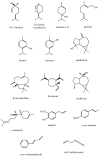Essential Oils and Their Components as Modulators of Antibiotic Activity against Gram-Negative Bacteria
- PMID: 28930130
- PMCID: PMC5456245
- DOI: 10.3390/medicines3030019
Essential Oils and Their Components as Modulators of Antibiotic Activity against Gram-Negative Bacteria
Abstract
Gram-negative bacteria cause infections that are difficult to treat due to the emergence of multidrug resistance. This review summarizes the current status of the studies investigating the capacity of essential oils and their components to modulate antibiotic activity against Gram-negative bacteria. Synergistic interactions are particularly discussed with reference to possible mechanisms by which essential oil constituents interact with antibiotics. Special emphasis is given to essential oils and volatile compounds that inhibit efflux pumps, thus reversing drug resistance in Gram-negative bacteria. In addition, indifference and antagonism between essential oils/volatile compounds and conventional antibiotics have also been reported. Overall, this literature review reveals that essential oils and their purified components enhance the efficacy of antibiotics against Gram-negative bacteria, being promising candidates for the development of new effective formulations against Gram-negative bacteria.
Keywords: Gram-negative bacteria; antibiotics; essential oils; multidrug-resistance; synergistic interactions.
Conflict of interest statement
The authors declare no conflict of interest.
Figures
Similar articles
-
Coriander essential oil and linalool - interactions with antibiotics against Gram-positive and Gram-negative bacteria.Lett Appl Microbiol. 2019 Feb;68(2):156-164. doi: 10.1111/lam.13100. Epub 2019 Jan 4. Lett Appl Microbiol. 2019. PMID: 30471142
-
Essential oils from Moroccan plants as potential chemosensitisers restoring antibiotic activity in resistant Gram-negative bacteria.Int J Antimicrob Agents. 2011 Oct;38(4):325-30. doi: 10.1016/j.ijantimicag.2011.05.005. Epub 2011 Jul 14. Int J Antimicrob Agents. 2011. PMID: 21752605
-
The ability of selected plant essential oils to enhance the action of recommended antibiotics against pathogenic wound bacteria.Burns. 2017 Mar;43(2):310-317. doi: 10.1016/j.burns.2016.08.032. Epub 2016 Oct 27. Burns. 2017. PMID: 28341256
-
Next-generation strategy for treating drug resistant bacteria: Antibiotic hybrids.Indian J Med Res. 2019 Feb;149(2):97-106. doi: 10.4103/ijmr.IJMR_755_18. Indian J Med Res. 2019. PMID: 31219074 Free PMC article. Review.
-
Antimicrobial Activity of Some Essential Oils-Present Status and Future Perspectives.Medicines (Basel). 2017 Aug 8;4(3):58. doi: 10.3390/medicines4030058. Medicines (Basel). 2017. PMID: 28930272 Free PMC article. Review.
Cited by
-
Chemical Characteristics of Ethanol and Water Extracts of Black Alder (Alnus glutinosa L.) Acorns and Their Antibacterial, Anti-Fungal and Antitumor Properties.Molecules. 2022 Apr 28;27(9):2804. doi: 10.3390/molecules27092804. Molecules. 2022. PMID: 35566154 Free PMC article.
-
Natural Solutions to Antimicrobial Resistance: The Role of Essential Oils in Poultry Meat Preservation with Focus on Gram-Negative Bacteria.Foods. 2024 Dec 3;13(23):3905. doi: 10.3390/foods13233905. Foods. 2024. PMID: 39682977 Free PMC article. Review.
-
The Influence of Basil and Cinnamon Essential Oils on Bioactive Sponge Composites of Collagen Reinforced with Hydroxyapatite.Materials (Basel). 2025 Jan 30;18(3):626. doi: 10.3390/ma18030626. Materials (Basel). 2025. PMID: 39942292 Free PMC article.
-
Pilot study on the potential of low-salt brine with oregano essential oil for post-preservation of white brined cheese.Sci Rep. 2025 Aug 1;15(1):28151. doi: 10.1038/s41598-025-13384-7. Sci Rep. 2025. PMID: 40750643 Free PMC article.
-
In-vitro determination of antimicrobial activities of Eruca sativa seed oil against antibiotic-resistant gram-negative clinical isolates from neonates: a future prospect.BMC Complement Med Ther. 2022 Aug 27;22(1):229. doi: 10.1186/s12906-022-03710-1. BMC Complement Med Ther. 2022. PMID: 36030221 Free PMC article.
References
-
- Summary of the Latest Data on Antibiotic Resistance in the European Union. [(accessed on 10 June 2016)]. Available online: http://ecdc.europa.eu/en/eaad/Documents/antibiotics-resistance-EU-data-2....
-
- Wolska K.I., Grześ K., Kurek A. Synergy between novel antimicrobials and conventional antibiotics or bacteriocins. Pol. J. Microbiol. 2012;61:95–104. - PubMed
Publication types
LinkOut - more resources
Full Text Sources
Other Literature Sources
Molecular Biology Databases


